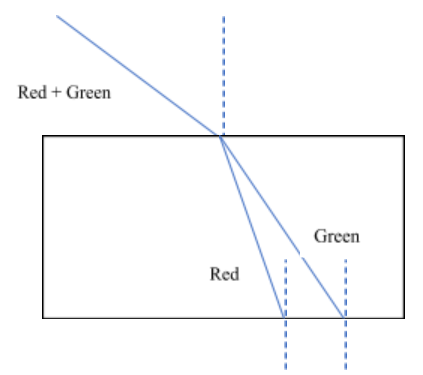
A beam of light composed of red and green rays is incident obliquely at a point on the face of a rectangular glass slab. When coming out on the opposite parallel face, the red and green ray emerge from
A) Two points propagating in two different parallel directions
B) One point propagating in two different directions through slab
C) One point propagating in the same direction through the slab
D) Two points propagating in two different non-parallel directions
Answer
165.6k+ views
Hint: A beam of light composed of red and green ray when incidents on the glass slab forms an angle with the normal called incidence angle. Then, while passing through the rectangular glass slab gets separated into two rays. Both the rays move at different angles with the normal and thus have different angles of refraction.
Complete answer:

Different colors have different velocities. Thus, the velocity of red is different from the velocity of green. Due to different velocities, in a given medium, red and green refract at different angles of refraction. Thus, due to different angles of refraction they appear on opposite faces at two different points after emerging from the glass slab and move in two different parallel directions.
Hence, the correct answer is option A i.e. two points propagating in two different parallel directions.
Note: The velocity of different colours is the same in vacuum or air. When a light ray travels from one medium to another with different densities or refractive indices, then the ray refracts. However, if the light tray travels in the same medium throughout the journey then instead of refraction the ray gets reflected. There are certain laws related accompanied with reflection. The angle of incidence has to be always equal to the angle of reflection.
Complete answer:

Different colors have different velocities. Thus, the velocity of red is different from the velocity of green. Due to different velocities, in a given medium, red and green refract at different angles of refraction. Thus, due to different angles of refraction they appear on opposite faces at two different points after emerging from the glass slab and move in two different parallel directions.
Hence, the correct answer is option A i.e. two points propagating in two different parallel directions.
Note: The velocity of different colours is the same in vacuum or air. When a light ray travels from one medium to another with different densities or refractive indices, then the ray refracts. However, if the light tray travels in the same medium throughout the journey then instead of refraction the ray gets reflected. There are certain laws related accompanied with reflection. The angle of incidence has to be always equal to the angle of reflection.
Recently Updated Pages
Classification of Elements and Periodicity in Properties | Trends, Notes & FAQs

JEE Main 2021 July 25 Shift 1 Question Paper with Answer Key

JEE Main 2021 July 22 Shift 2 Question Paper with Answer Key

How to Calculate Moment of Inertia: Step-by-Step Guide & Formulas

Dimensions of Charge: Dimensional Formula, Derivation, SI Units & Examples

Dimensions of Pressure in Physics: Formula, Derivation & SI Unit

Trending doubts
JEE Main 2025 Session 2: Application Form (Out), Exam Dates (Released), Eligibility, & More

Combination of Capacitors - In Parallel and Series for JEE

Uniform Acceleration

Atomic Structure - Electrons, Protons, Neutrons and Atomic Models

Displacement-Time Graph and Velocity-Time Graph for JEE

JEE Main 2025: Derivation of Equation of Trajectory in Physics

Other Pages
JEE Advanced Marks vs Ranks 2025: Understanding Category-wise Qualifying Marks and Previous Year Cut-offs

NCERT Solutions for Class 11 Physics Chapter 1 Units and Measurements

NCERT Solutions for Class 11 Physics Chapter 2 Motion In A Straight Line

Units and Measurements Class 11 Notes: CBSE Physics Chapter 1

Motion in a Straight Line Class 11 Notes: CBSE Physics Chapter 2

Important Questions for CBSE Class 11 Physics Chapter 1 - Units and Measurement




